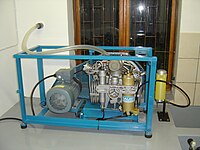
Hierarchical and distributed demand response control strategy for thermostatically controlled appliances in smart grid
Sign Up to like & getrecommendations! Published in 2017 at "Journal of Modern Power Systems and Clean Energy"
DOI: 10.1007/s40565-016-0255-y
Abstract: Thermostatically controlled appliances (TCAs) have great thermal storage capability and are therefore excellent demand response (DR) resources to solve the problem of power fluctuation caused by renewable energy. Traditional centralized management is affected by communication… read more here.
Keywords: thermostatically controlled; control; demand response; strategy ... See more keywords

Multi-agent reinforcement learning for modeling and control of thermostatically controlled loads
Sign Up to like & getrecommendations! Published in 2019 at "Applied Energy"
DOI: 10.1016/j.apenergy.2019.01.140
Abstract: Abstract Increasing energy efficiency of thermostatically controlled loads has the potential to substantially reduce domestic energy demand. However, optimizing the efficiency of thermostatically controlled loads requires either an existing model or detailed data from sensors… read more here.
Keywords: control; multi agent; thermostatically controlled; energy ... See more keywords

Hierarchical control of thermostatically controlled loads oriented smart buildings
Sign Up to like & getrecommendations! Published in 2019 at "Applied Energy"
DOI: 10.1016/j.apenergy.2019.113493
Abstract: Abstract With the transition of energy systems, synergetic interaction between consumers and suppliers has been an inevitable trend. As a demand response (DR) resource, thermostatically controlled loads (TCLs) can respond to power fluctuations in power… read more here.
Keywords: control; communication; hierarchical control; thermostatically controlled ... See more keywords

Equivalent electricity storage capacity of domestic thermostatically controlled loads
Sign Up to like & getrecommendations! Published in 2017 at "Energy"
DOI: 10.1016/j.energy.2016.12.096
Abstract: Abstract A method to quantify the equivalent storage capacity inherent the operation of thermostatically controlled loads (TCLs) is developed. Equivalent storage capacity is defined as the amount of power and electricity consumption which can be… read more here.
Keywords: tcls; thermostatically controlled; storage capacity; storage ... See more keywords

Human in the loop heterogeneous modelling of thermostatically controlled loads for demand side management studies
Sign Up to like & getrecommendations! Published in 2017 at "Energy"
DOI: 10.1016/j.energy.2017.12.120
Abstract: Abstract Demand Response (DR) is a Smart Grid technology aiming to provide demand regulation for dynamic pricing and ancillary services to the grid. Thermostatically controlled loads (TCLs) are among those with the highest potential for… read more here.
Keywords: thermostatically controlled; heterogeneity; human loop; heterogeneous modelling ... See more keywords

Demand response based desynchronization of thermostatically controlled loads with hardware implementation
Sign Up to like & getrecommendations! Published in 2020 at "AIP Advances"
DOI: 10.1063/1.5128729
Abstract: Smart buildings are the need of the day with increasing demand-supply ratios and considerable deficiency to generate them. In any modern nonindustrial infrastructure, these demands mainly comprise thermostatically controlled loads (TCLs), which can be maneuvered.… read more here.
Keywords: thermostatically controlled; power; achieve desired; desynchronization ... See more keywords

Thermostatically Controlled Loads in the Power System Under Cyberattacks
Sign Up to like & getrecommendations! Published in 2023 at "IEEE Internet of Things Journal"
DOI: 10.1109/jiot.2022.3222304
Abstract: More and more thermostatic loads in power systems are transformed into thermostatically controlled loads (TCLs) through the heterogeneous Internet of Things (IoT) devices. The proportion of TCLs exposed to the Internet has also further increased.… read more here.
Keywords: controlled loads; power systems; iot devices; power ... See more keywords

A Geometric Approach to Aggregate Flexibility Modeling of Thermostatically Controlled Loads
Sign Up to like & getrecommendations! Published in 2017 at "IEEE Transactions on Power Systems"
DOI: 10.1109/tpwrs.2017.2674699
Abstract: Coordinated aggregation of a large population of thermostatically controlled loads (TCLs) presents a great potential to provide various ancillary services to the grid. One of the key challenges of integrating TCLs into system-level operation and… read more here.
Keywords: thermostatically controlled; flexibility; aggregate flexibility; controlled loads ... See more keywords

Hierarchical Control of Thermostatically Controlled Loads for Primary Frequency Support
Sign Up to like & getrecommendations! Published in 2018 at "IEEE Transactions on Smart Grid"
DOI: 10.1109/tsg.2016.2624509
Abstract: This paper proposes a hierarchical control of thermostatically controlled loads (TCLs) to provide primary frequency control support. The control architecture is composed of three levels. At the high level, an aggregator coordinates multiple distribution substations… read more here.
Keywords: thermostatically controlled; control thermostatically; frequency; control ... See more keywords

Robust Distribution System Expansion Planning Incorporating Thermostatically-Controlled-Load Demand Response Resource
Sign Up to like & getrecommendations! Published in 2022 at "IEEE Transactions on Smart Grid"
DOI: 10.1109/tsg.2021.3121658
Abstract: Smart meter data provides rich information on customers’ energy consumption behaviors, which can be a valuable resource for evaluating customers’ demand response (DR) potential and thus can inform the distribution system expansion planning (DSEP). This… read more here.
Keywords: distribution system; system expansion; demand response; expansion planning ... See more keywords

Statistical Mechanics of Thermostatically Controlled Multi-Zone Buildings
Sign Up to like & getrecommendations! Published in 2022 at "Physical review. E"
DOI: 10.48550/arxiv.2208.13099
Abstract: We study the collective phenomena and constraints associated with the aggregation of individual cooling units from a statistical mechanics perspective. These units are modeled as thermostatically controlled loads (TCLs) and represent zones in a large… read more here.
Keywords: multi zone; controlled multi; mechanics thermostatically; statistical mechanics ... See more keywords